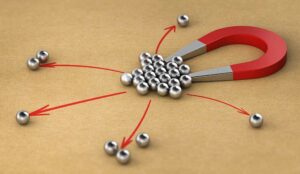Satisfying customers is a core objective for every business. Happy, loyal customers keep companies in the black, and strategies abound for improving customer outcomes across an organization. That’s why it’s important to measure customer attrition and take action to reduce and prevent customer churn.
How Do You Measure and Prevent Customer Churn?
Use this formula to calculate your net churn rate:
Net Churn Rate = Number of Lost Customers / Total Number of Customers
To reduce and prevent customer churn, keep an eye on this metric while taking steps to:
- Refine your targeting to focus on your ideal customers
- Provide better customer support and guidance
- Identify customer behaviors that indicate a risk of churn
- Identify the actions, behaviors, and messaging that drive customer retention
- Fine-tune your interactions with customers across every touchpoint throughout the customer journey
Mastering the metrics that inform your decisions on how to keep your customers around should be at the top of your priority list, and customer churn is one metric that matters much more than most in this regard.
Customer churn can be a real killer if left unchecked. Here, we’ll define the phenomenon, its attendant metric and a few methods to prevent it in the first place.
What is Customer Churn?
Customer churn is all about customers — paying customers — and the rate at which your company is losing them to its competitors. The phenomenon goes by many names, including customer defection, attrition and dropout, but these all mean the same thing.
Churn has the power to affect all facets of your company’s operations by directly impacting cash flow. This makes your churn rate particularly indicative of your business’s overall performance. After all, an organization that cannot hold onto its customers is unlikely to survive over the long term.
Measuring Customer Churn
Without measuring customer churn, it can be incredibly difficult to gain a clear understanding of how well your company is actually performing. Thankfully, customer churn is relatively straightforward to measure and track. Churn of this kind comes in two distinct forms:
Gross Churn:
This is the total number of customers that have left your company or ceased using the products and services that you provide. This is the best metric to use if you want to understand how well your company is performing with its customers at a given time.
Net Churn Rate:
This is the same measurement of customers that have stopped using your products or services, balanced out by also accounting for the number of new customers that have been onboarded over the same period. This metric is perfect for tracking the growth rate of your customer base.
Calculating your business’s gross customer churn is as easy as figuring out how many customers have stopped doing business with you or otherwise become inactive. This figure can then be limited to a specific period to make it more useful.
Net Churn Rate Formula
Use this simple formula to calculate the net customer churn rate across your organization:
Net Churn Rate = Number of Lost Customers / Total Number of Customers
This formula is normally limited to more specific timeframes to yield better insights about the way that an organization’s churn rate has developed over time. For instance, you can calculate net churn for a specific month as opposed to the entire lifetime of your company.
Preventing Customer Churn
Customer churn is especially important for businesses to address as it indicates something being amiss with existing processes. If the causes of customer churn are left to grow, they can threaten the sustainability of your entire business model.
Prevention is arguably far better than a cure where customer churn is concerned, but you’ll need to reach beyond the bounds of metrics and measurements to make a difference in this area. A proactive stance that takes aim at all the root causes of customer churn can involve any of the following tactics:
Focus On What Keeps Customers Happy
This may seem obvious, but it helps to pay closer attention to the things that encourage customers to stay with your company if you want your churn rate to come down at all.
It is far too easy for companies to end up fighting fires in an attempt to eliminate things that turn customers away, while missing the opportunity to strengthen the motivators at play in convincing them to stay put.
Offering more value to your customers and considering more of their needs can go a long way in reducing their risk of churning.
Conversation intelligence provides a wealth of information, analyzing every customer interaction to identify patterns in speech, sentiment, and behaviors that increase a customer’s likelihood to churn or, alternatively, improve customer satisfaction, increase retention and foster loyalty.
Give Guidance to Your Customers
One of the most surefire ways that you can turn customers off and run them away is by abandoning them altogether when they are trying to use your product or service.
Reduce customer effort score (CES) by making it easy for your customers to do business with you and to obtain the help and guidance they need when they need it.
Guidance is one of the greatest gifts that you can give them as it helps them help themselves at whatever pace best suits them.
Anything from an open knowledge base or forum to a suite of tutorials and free one-on-one training sessions can inspire your customers to stick to your company instead of churning into competitors’ open arms.
Coupled with an efficient contact centre with high-performing agents readily available to answer questions and resolve issues when customers need them, robust and easy to use self-service solutions put valuable resources at your customers’ fingertips.
Refine Your Targeting
Making all the right moves won’t make much of a difference for your churn rate if you’re doing so with all the wrong customers.
Attracting and retaining the kinds of customers who are looking for quality as opposed to the cheapest offer or a bargain is bound to produce better results for your business.
Customer intelligence solutions not only help you discover what keeps your existing customers happy, but it also provides valuable insights into the likelihood of customer loyalty for different customer personas and what types of customers tend to have the highest customer lifetime value (CLV).
Armed with this data, you can improve your marketing and sales efforts to more effectively target your ideal customers, cultivate loyal customers and brand advocates, and improve the bottom line.
Ultimately, reducing customer churn comes down to uncovering what makes your customers tick and then molding your marketing, sales, customer support, and communications to meet their needs and wants.
Refining your targeting to focus on your ideal customer, reducing customer effort score, and leveraging interaction analytics to discover your customers’ needs, preferences, and priorities will put your company on the path to cultivating loyal customers and brand advocates.
This blog post has been re-published by kind permission of CallMiner – View the Original Article
For more information about CallMiner - visit the CallMiner Website
Call Centre Helper is not responsible for the content of these guest blog posts. The opinions expressed in this article are those of the author, and do not necessarily reflect those of Call Centre Helper.
Author: CallMiner
Published On: 19th Jan 2023
Read more about - Guest Blogs, CallMiner






 CallMiner is the leading cloud-based customer interaction analytics solution for extracting business intelligence and improving agent performance across all contact channels.
CallMiner is the leading cloud-based customer interaction analytics solution for extracting business intelligence and improving agent performance across all contact channels. 


































